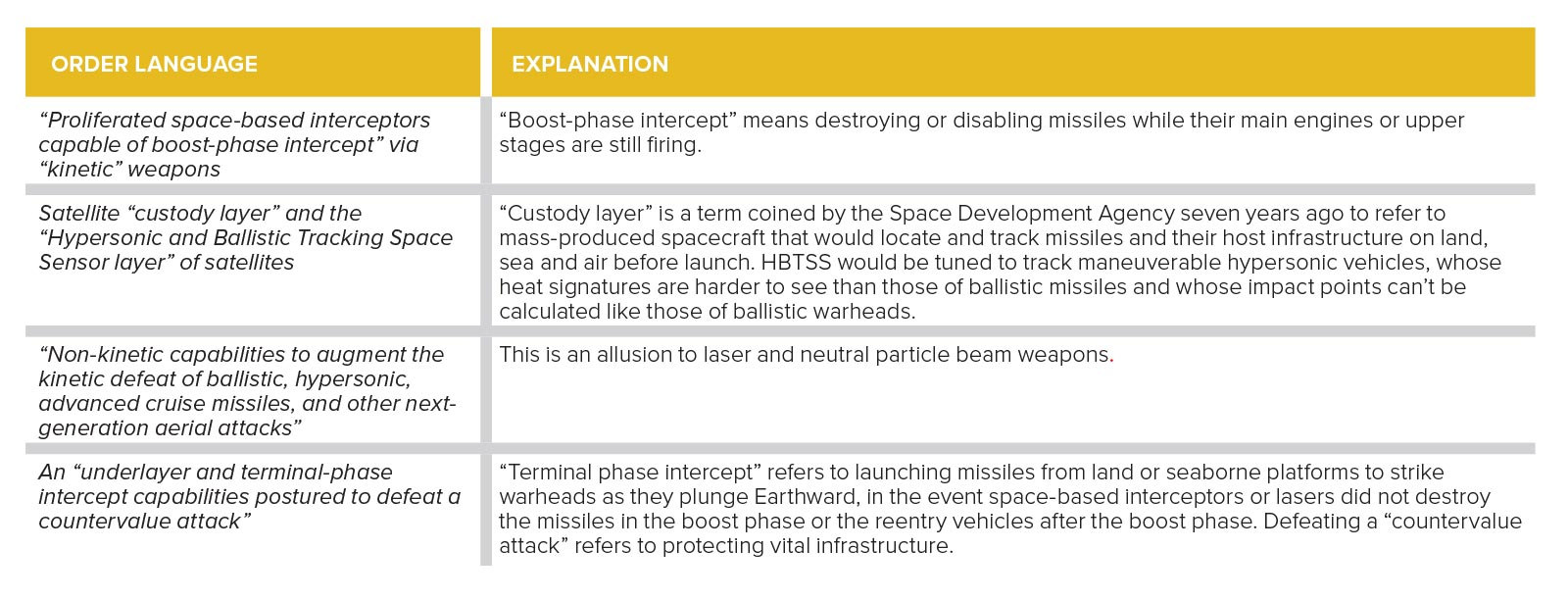Stay Up to Date
Submit your email address to receive the latest industry and Aerospace America news.
U.S. defense planners and the industry have so many technologies they lacked in the 1980s that, this time, creating defenses to shoot down missiles and warheads from space could be the path to a safer world. Fred Kennedy examines the strategy and math behind the proposal.
Forty years of advances in critical technologies undergird the Trump administration’s audacious proposal to protect the U.S. homeland not just from rogue missile strikes by the likes of Iran or North Korea but from nuclear-armed peer adversaries, China and Russia.
In 1983, detractors rose up to deride President Reagan’s challenge to American scientists to render nuclear weapons “impotent and obsolete.” They questioned the feasibility and practicality of this Strategic Defense Initiative, branding it “Star Wars” because of the plan to orbit weapons in space that would shoot down missiles or the warheads they release. Over the next couple of decades, the SDI organization morphed through a succession of acronyms, arriving at MDA, the Missile Defense Agency, while the objectives simultaneously migrated away from “national” missile defense to something more prosaic and limited in scope: the ability to shoot down small numbers of missiles fired at the homeland by rogue nations.
My analysis of President Donald Trump’s executive order, “The Iron Dome for America,” in light of today’s technologies strongly suggests that the math related to raid sizes and cost does in fact close. The goal of comprehensive though not entirely foolproof missile defense of the homeland from space looks to be both feasible and practical.
The order, published seven days after the inauguration, calls for development and deployment of some very intriguing components:

With these and other tools, Defense Secretary Pete Hegseth was instructed to submit a “reference architecture” for the figurative dome within 60 days of the Jan. 27 order.
It’s only been weeks, and all the arguments that 1980s skeptics deployed against SDI are already back on full display. We’re told that space-based interceptor missiles must be heavy and expensive and that they’ll always be on the wrong side of the globe when you need them (the “absenteeism” problem cited by the Center for Strategic and International Studies think tank and others). We’re also told this architecture of space-based weapons can’t be scaled to meet the threat, because as the number of missiles per attack — the “raid size” — increases, the number of interceptors required to knock down the missiles and their payloads increases linearly. In this view, the adversary simply “adds another missile,” and the architecture becomes impractical. Lasers and neutral particle beam weapons are dismissed as requiring too much power.
This warmed-over criticism misses how much the technical world has changed since the Reagan era. While I was helping stand up the Space Development Agency in 2018, we were all keenly aware of plans by OneWeb, SpaceX, Amazon and others to launch constellations of hundreds to thousands of satellites in low-Earth orbit to offer communications normally provided by geosynchronous equatorial satellites. Inspired by these large, or proliferated, architectures, Pentagon leadership in 2019 chartered SDA to rapidly procure and fly large numbers of inexpensive, relatively small satellites for missile defense.
We at SDA envisioned development of a Custody Layer, a constellation that would be equipped with moving target indicator radar, imaging radar and other sensors, to keep tabs on an adversary’s offensive “internet of things.” That was our term for their missile transporters, bombers, marine vessels — any nonstatic vehicle that might conceivably lob a missile at the United States. These satellites would be the equivalent of Joint Surveillance Target Attack Radar System and U-2 aircraft, but in space. To strike a missile, you have to know where it could be launched from, after all. Complementing the Custody Layer was the Tracking Layer, the satellites that would detect and track hypersonic or ballistic weapons after launch. A Transport Layer would connect sensors and shooters, while hosting battle management software to ensure that sensor data is interpreted accurately and orders are communicated efficiently and securely. As a start, SDA and its vendors deployed 23 Transport and Tracking Layers satellites in 2023. MDA, meanwhile, started planning its own proliferated constellation, the Hypersonic and Ballistic Tracking Space Sensor satellites. SDA and MDA joined forces to deploy four more Tracking Layer satellites and two HBTSS prototypes in 2024. SDA has yet to deploy any of its Custody Layer satellites, but plans call for a “Gamma” variant of the Transport Layer spacecraft — some of which are scheduled to be launched as early as 2026 — that will have some “add-on” features that address Custody Layer targets. Together, these layers will compose SDA’s Proliferated Warfighter Space Architecture.
Why is the Defense Department so confident that the industry can deliver what’s needed, if we’ve only launched a couple handfuls of our own birds to date? The answer boils down to the almost 650 OneWeb and 7,000 Starlink satellites orbiting overhead. Those show that mass-produced, relatively small spacecraft are both feasible and practical. What may not be as clear is how this lesson in mass-production and micro-miniaturization of electronics can be applied to space-based interceptors.
Let’s start with some recent history related to that. Until about 10 years ago, big primes and their government managers often dismissed small satellites as toys. I’ve been in the room for these kinds of debates, which usually centered on how big, exquisite systems do vitally important things we just can’t live without. Flash forward, and the same microelectronics revolution that gave us the iPhone 16 also permits us to launch kilogram cubesats with all the necessary guidance, communications, power and sensing capabilities to do much of the work of their larger brethren. So too with interceptors. But not everyone is on the same page. Todd Harrison, in a January posting on the website of the American Enterprise Institute where he is a senior fellow, pointed to a 2004 report stating that a space-based interceptor would tip the scales at an eye-watering 900 kg (just under a U.S. ton).
The thing is, there’s been lots of progress since 2004. It’s now well within our means for us to build a space-based interceptor that’s no larger than an AIM-9 anti-aircraft missile (about 80 kg). Don’t take my word for it. From 2011 to 2015, DARPA investigated rockets small enough to be carried by a modified F-15 that could place 45-kg satellites on orbit — part of its Airborne Launch Assist Space Access program. In 2018, DARPA kicked off Glide Breaker, an initiative to mature key components of a lightweight kill vehicle that could engage hypersonic weapons.
Now, here’s the math: Put six interceptors into the orbital equivalent of the magazine of a Multiple Launch Rocket System, and attach this to a small satellite “front end.” Launch 21 of these carriers on a Falcon 9 (or a competitor’s vehicle). Do that 13 times, and you’ll have 273 interceptor carriers hosting almost 1,700 individually targetable interceptors. Each carrier with its complement of six interceptors might mass as little as 750 kg (1,650 lbs). That’s about the same as a second-generation Starlink satellite. Now, here’s the interesting bit: Perhaps we approach SpaceX or OneWeb and ask them to sell us satellites off their existing production lines. A first-generation Starlink (260 kg or 572 lbs) or OneWeb (150 kg or 330 lbs) could serve as an inexpensive, reliable interceptor carrier’s front end. If we conservatively estimate the unit cost of these spacecraft at $1 million or less (and a similar figure for the interceptor), we aren’t breaking the bank. This is a $2 billion problem — not a $20 billion problem. The Defense Department just needs to leverage the economies of scale our commercial space industry is already bringing (they’d have to want to help, of course). And as launch costs continue to fall, owing to the advent of the Starship and New Glenn launch vehicles, the once insurmountable deployment problem goes away as well. SpaceX orbited 1,800 Starlink satellites in 2024 over 89 launches. This sort of launch rate would have been thought unattainable 20 years ago. A 273-interceptor carrier constellation could be fielded in months with just a small fraction of the launchers SpaceX flew last year.
What about absenteeism and scale? Well, let’s revisit the physics. Our 273 carriers offer global coverage and the opportunity to address missile launches in both boost phase and midcourse (when ballistic missiles, reentry vehicles and countermeasures are coasting through space en route to their targets). My own modeling suggests that such a constellation would be robust against substantial raids. For a hypothetical attack emanating from Eurasia, up to 17 carriers (and their 102 interceptors) would be able to engage over the course of a 33-minute flight, despite tight constraints on geometry and achievable delta-V, the term for how much change in velocity the rocket needs to produce. For a raid size of five or 10 missiles, this is more than sufficient. Bump the raid size to 50, and it’s still possible to achieve an attrition rate of 96% — that’s 48 missiles — given certain assumptions about an individual interceptor’s probability of kill.
Now, a critic might argue that such a missile defense isn’t worth it because two nuclear missiles could still get through. And I concede, this would indeed be a tragic day for the United States and humanity. But — crucially — it would not end humanity. Back to raid sizes: For anything much above 50, we can expect the threat to come from multiple geographically dispersed regions. As a result, there would always be untasked interceptors ready to target them. That’s absenteeism turned on its head: Capacity is always emerging over the horizon in the form of interceptor carriers.
As for scale, it’s all about winning the war of one-more-missile versus two-more-interceptors. The math tells us the competition is no longer even close. An intercontinental ballistic missile is a big, complex, expensive piece of hardware designed to impart a delta-V of 6 or 7 kilometers per second to a large pallet holding reentry vehicles. ICBMs cost about $10-15 million each. Our interceptors and their carrier platforms will cost an order of magnitude less, and each carrier will be able to target two, three or perhaps even four missiles in flight before depleting its magazine. That’s trading a few million of our dollars for up to $60 million of an adversary’s ballistic missiles, payloads and related gear. The mantra that “one more missile” defeats your defenses just doesn’t cut it in the New Space era.
That’s the story of space-based interceptors, but I would close with the oft-heard lament over the shortage of available power that bedevils “speed of light” weaponry, such as the lasers that the administration is counting on to augment kinetic interceptors. This is something we’ve been quite remiss at addressing as a nation: namely, the adoption of nuclear power and propulsion on orbit. (Disclosure: the company I co-founded, Dark Fission Space Systems, is pioneering nuclear thermal rocket technology for travel through cislunar space.) With six orders of magnitude greater energy density than chemical energy storage and 1,000 times the power density of solar power, nuclear energy will enable not just laser weapons but communications, resource extraction, habitats, planetary defense and fast access to anywhere in the solar system. By getting missile defense right, we humans will still be around to do those things.
Opener caption: A notional constellation of 273 interceptor carriers. Each of these satellites would be equipped with six missiles that could intercept missiles or nuclear warheads targeting the United States. Credit: Fred Kennedy with the Satellite Tool Kit
About Fred Kennedy
Fred was the inaugural director of the U.S. Space Development Agency and a former director of DARPA’s Tactical Technology Office. A retired Air Force colonel and AIAA senior member, he holds a Ph.D. in electronics and physical sciences from the University of Surrey and degrees in aeronautics and astronautics from the Massachusetts Institute of Technology. He is CEO of Dark Fission Space Systems.
Related Posts
Stay Up to Date
Submit your email address to receive the latest industry and Aerospace America news.




